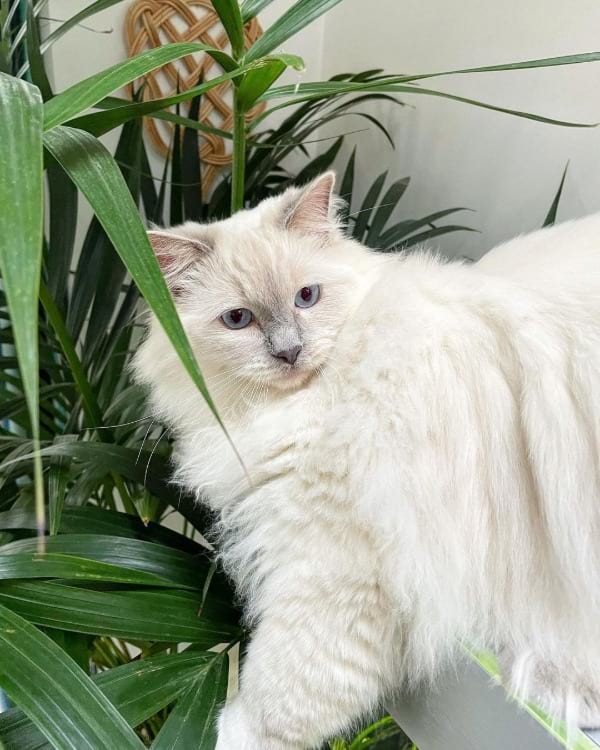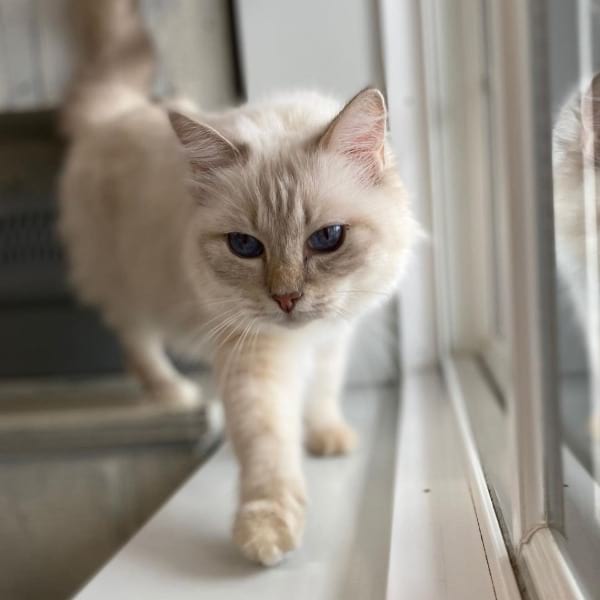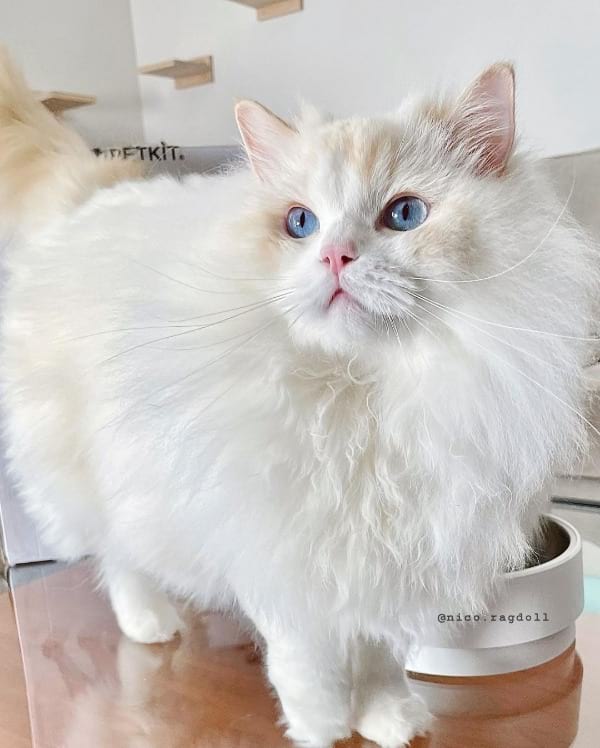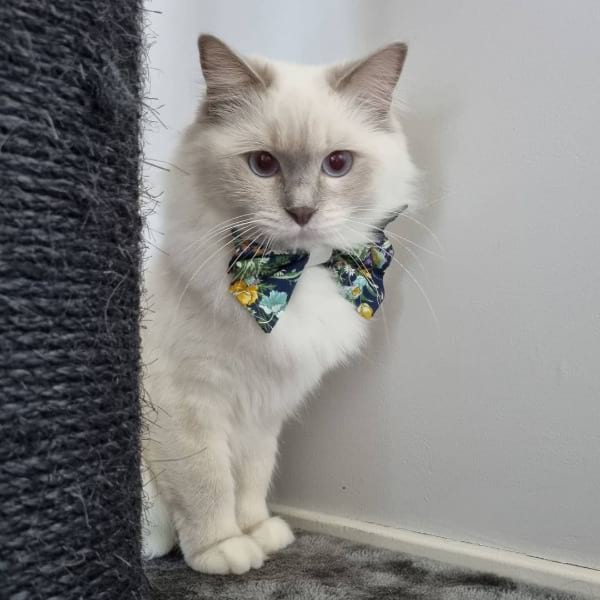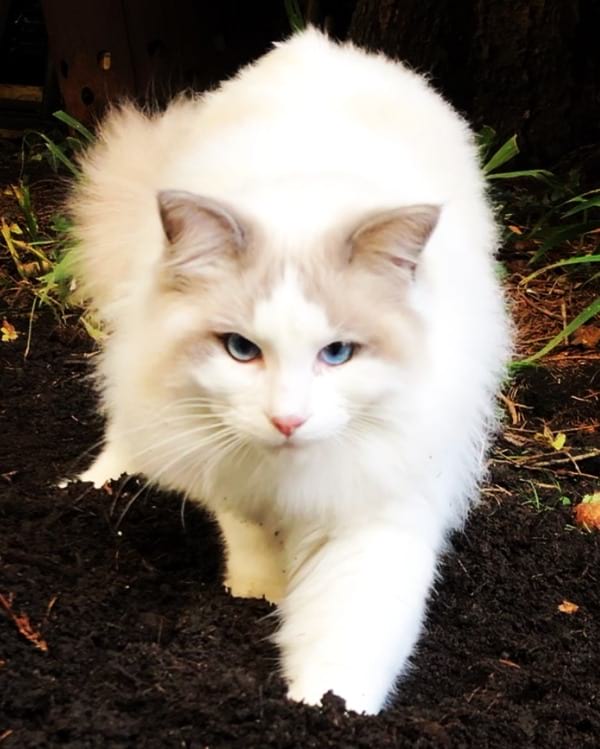Ragdoll cats are very popular around the world. One of their most attractive colorations is the lilac point with eye-catching pinkish tones that balance well with the white body parts of these gorgeous felines.
If you are searching for a lilac Ragdoll, be ready that there are several possible patterns like lynx, bicolor, lilac mink Ragdoll, and mitted variations. Additionally, solid lilac Ragdoll cats vary according to the dominant colorprint. For example, you can adopt a cream lynx point bewhiskered pet or the one with pinkish tone patterns.
If we speak about mixed breed colorations, blue-pointed Ragdolls can combine both cool grey with azure shading together with pink nose leather and light pink hue. It looks awesome — all the cats are so cute and colorful!
Let’s dive into the topic of lilac cat males and females of the Ragdoll breed. Find answers to your questions here.
What Is a Lilac Point Ragdoll?
Lilac Ragdoll cats are felines with milk-white color fur accompanied with pale grey and cream colors. Some people confuse lilac-colored bewhiskered buddies with blue ones. If we speak about the differences in the context of lilac vs blue Ragdoll cats, lilac-friendly pets will surely obtain a lilac hue.
In comparison with red Ragdolls with flame and bright orange colors and warm striping, lilac kitties are notable for their cold colorprint with frosty grey or lavender-pink (even light purple) tones. These patterns occur due to the dilute pigment that is responsible for the lilac cat colors.
Lilac-colored cats of the Ragdoll breed are the combination of grey and cream colors together with the white coloration of the belly, back, and a feline’s chest. Usually, lilac body shading takes place on the nose, kitties’ forehead, cheeks, paw pads, ears, and tail end. It is worth noting that lilac-colored Ragdolls are one of 6 possible colorations. Other pattern variations are:
- Solid point (tabby markings);
- Lynx point coloring;
- Tortie-lynx mix;
- Ragdolls with tortie points (tortoise).
Besides pointed coloration, cats of this breed can be mitted, bicolor (bi-color), and of van pattern. It is worth noting that lilac, creamy, pinkish, and other Ragdoll cat colors become well-visible on the kittens’ fur 1-2 months after their births.
It means that kitties are born white or with a 100% milk-colored coat. Some pale points of champagne, powder, or ghost pink-edged patterns can touch only the baby’s nose leather and paw pads.
Many experts state that the body temperature of the kitty from birth matters when it comes to the brightness and intensity of the colorpoints. The warmer are living conditions of the bewhiskered baby; the more possible their white fur will be covered with the points of darker colors.
Lilac Ragdoll Cat Patterns
Lilac Ragdoll cats are beautiful felines with big bright blue eyes and exceptional color patterns on the glacial white or milky-colored coat. These are bewhiskered buddies with light cream mottling points and a pinkish tinge.
There are five color pattern variations to take into account when it comes to lilac Ragdoll kittens and adult cats.
Lilac Lynx Point Ragdoll Cats
A lilac lynx Ragdoll is a feline with a white liner under the eyes and narrow lilac bars on the forehead and cheeks. These stripes are visible on the paws as well. All the lynx lilac Ragdoll buddies have darker shading with pinkish tones on their nose leather, ears, and tail end.
Some breeding specialists state that there are also interesting mixes of lynx, tabby, and mitted color variations.
Lilac Cream Ragdoll Cats
The dominance of creamy colors over frosty grey is about these Ragdolls. These felines obtain cappuccino markings and pink paw pads. Almost 90% of these bewhiskered buddies are snow-white with peach-colored shadings on the chest, under the eyes, on the tail, and on the ears.
Lilac Cream Lynx Point Ragdoll Cats
This is a blend of lynx features together with a tandem of creamy and grey colors. The pinkish with cappuccino colorpoints are seen on the face in the form of the W-shaped mask. The ends of the Ragdoll feline’s ears are mostly of the cold grey coloration.
Lilac Mitted Ragdoll
The most notable features are shadings and stripes on the Ragdoll cat’s paws, so-called mittens on the feline’s pads. Lilac colorpoint Ragdoll cats can vary from the bright lavender pink to the pale powder-like or thin grey. Mitted Ragdoll felines might obtain some characteristics of the lynx and bi-colored pets.
Lilac Bicolor Ragdoll
The lilac bicolor Ragdoll does not contain any tripled number of colors on the fur. The combination contains only two colorpoints where white is the essential one and pinkish, creamy, lavender, or other tones will be presented for markings. Lilac bicolor Ragdoll felines often have exceptional masks on the face in the form of the overturn V, W.
Frequently Asked Questions
If you still have some questions about lilac Ragdoll cats with a totally attractive appearance and very affectionate nature, feel free to find all the necessary answers in the FAQ section.
Is Lilac a Recognized Ragdoll Cat Color?
The Cat Fanciers Association recognizes Lilac as a Ragdoll cat color. It is one of the most popular Ragdoll cat colors, as well as one of the most attractive.
Are Lilac Point Ragdolls Rare?
These felines obtain a rather rare genetic portfolio. Each lilac Ragdoll kitten has the dilute pigment that is responsible for the lavender cat color or another pattern like the presence of frosty grey, pinkish tinge, cream, and other colors of the cold and pale gradient (including light purple and azure).
To sum up, a Ragdoll kitten in the litter with lilac fur is a 50 to 50 probability. But the rarest color pattern is still a mix of lilac and tortie colorprints.
Lilac vs Blue Ragdoll: What Is the Difference Between Lilac Point and Blue Point Ragdoll?
The main difference between lilac and blue Ragdolls is that most blue-pointed Ragdoll cats do not have any pinkish stripes and patches on their paws, tails, and faces. At the same time, a lilac Ragdoll colorpoint is impossible without cream, pink, and purple shading and coloring. The common feature of these felines is the cold coloration instead of the dominance of a warm tinge like flame or chocolate points.
Are Lilac Ragdoll Cats Purple?
Yes, some catteries are breeding lilac felines with definite light purple patterns. It is possible to adopt lavender or purple-colored bi-color, lynx, and mitted Ragdolls. A gradient and the brightness of the feline’s body color usually depend on the genetic profile, temperature variations, and other individual factors.
What Color Are Lilac Ragdolls’ Eyes?
These felines have bright blue eyes in most cases. Sometimes, a range of genetic exceptions can take place. This way lilac Ragdolls’ eyes might gain the grey or green gradient to the blue color and change the coloration depending on the brightness and other aspects.
Do Lilac Ragdolls Change Color?
Yes, it might happen due to the age-specific changes and the living conditions of the feline. A diet including regular menu items does not matter when it comes to the color variations (from lighter to darker).
What Does a Lilac Ragdoll Cat Look Like When Its Body Temperature Is Up?
If the Ragdoll kitten is raised indoors where it is rather warm, this she-cat or he-cat may obtain a darker coat in the adult and mature age.
What Does a Lilac Ragdoll Cat Look Like When Its Body Temperature Is Low?
If the Ragdoll kitten is raised indoors where it is rather cold, this baby may obtain a lighter coat in the adult and mature age.
At What Age Can You Tell That a Ragdoll Cat is Lilac?
A Ragdoll kitten is born without lilac markings. It is possible to predict the approximate coat shading type only when the kitty is about 2-3 months old. During the lilac Ragdoll kittens’ first week, the owner can mention some pale stripes and patches on the face and paws. But the white fur begins to cover with well-visible colorpoints only after the 1st month of the feline’s life.
What Do Old Lilac Ragdoll Cats Look Like?
It doesn’t matter what colorprints your young lilac Ragdoll cat has. When the feline is aged, the fur becomes glacial white with too pale lilac cream points like small kittens have at the age of 1-2 months. This way all the lilac Ragdoll cats lose dark grey, tabby, purple, and pink-edged points when they are old.
Are Lilac Point Ragdolls Friendly?
These cats are often clever, inquisitive, and loving. These cats like spending time with people, especially if they were properly socialized as kittens. According to certain investigations, cats with color points, such as the lilac point Ragdoll, are more prone to separation anxiety. As a result, these cats require families that can devote a significant amount of time to them.
Do Lilac Ragdolls Have Pink Noses?
Yes, usually they have a rosy pink nose.
Are Lilac Point Ragdoll Cats Healthy?
There is no evidence that lilac points are associated with any specific health problems. White fur, on the other hand, has been related to deafness in certain purebred cats. As a result, you should select a reputable breeder who does not include any cats with hearing impairments in their breeding program.
How Much Do Ragdoll Lilac Point Cats Cost?
Their prices will vary between $800 and $2,500. Some show-bred Ragdolls can cost more than $2,500.
Lilac Ragdolls: To Sum Up
Frosty grey color with pink tinges is about lilac Ragdolls. They are very friendly and extremely beautiful. The most exotic coloration like deep lavender-pink or bright creamy with grey colorpoints is breeding delicately by the catteries according to the genetic profiles of the kittens’ parents.
If you would like to become the owner of the lilac Ragdoll kitty with the precise hue specifics or other parameters, it is necessary to wait for 1-2 months. After the kitten’s birth, lilac Ragdolls are mostly white and do not obtain well-recognized shading and markings. At the age of 2-3 months, it is possible to predict the rarest color pattern and adopt an exclusive lilac-colored feline!
Table of Contents
